SINGER 9970 User Manual
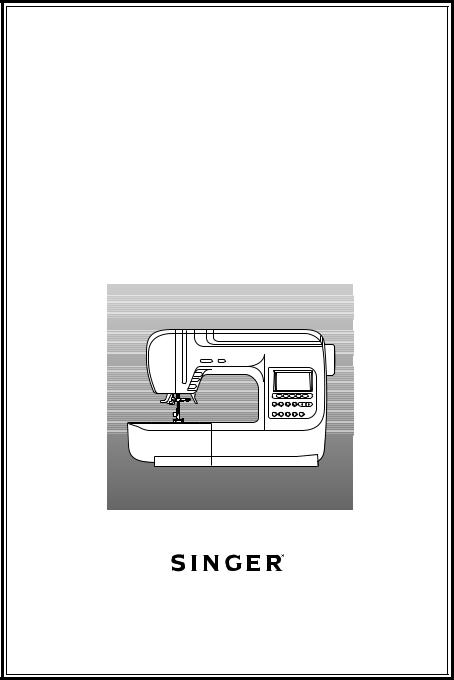
INSTRUCTION MANUAL
9970

INSTRUCTION MANUAL 

This sewing machine is intended for household use.
This sewing machine is not intended for use by young children or infirm persons without supervision.
IMPORTANT SAFETY INSTRUCTIONS
When using a sewing machine, basic safety precautions should always be followed, including the following.
Read all instructions before using.
 DANGER - To reduce the risk of electric shock:
DANGER - To reduce the risk of electric shock:
Never leave unattended when plugged in. Always unplug this machine from the electric outlet immediately after using and before cleaning.
WARNING - To reduce the risk of burns, fire, electric shock, or injury to persons:
1.Do not allow to be used as a toy. Close attention is necessary when this sewing machine is used by or near children.
2.Use this sewing machine only for its intended use as described in this manual. Use only attachments recommended by the manufacturer as contained in this manual.
3.Never operate this sewing machine if it has a damaged cord or plug, if it is not working properly, if it has been dropped or damaged, or dropped into water. Return the sewing machine to the nearest authorized dealer or service center for examination, repair, electrical or mechanical adjustment.
4.Never operate the sewing machine with any air openings blocked. Keep ventilation openings of the sewing machine and foot controller free from the accumulation of lint, dust, and loose cloth.
5.Never drop or insert any object into any opening.
6.Do not use outdoors.
7.Do not operate where aerosol (spray) products are being used or where oxygen is being administered.
8.To disconnect, turn the power switch to the off position (symbol “O”), then remove plug from outlet.
9.Do not unplug by pulling on cord. To unplug, grasp the plug, not the cord.
10.Keep fingers away from all moving parts. Special care is required around the sewing machine needle.
11.Always use the proper needle plate. The wrong plate can cause the needle to break.
12.Do not use bent needles.
13.Do not pull or push fabric while stitching. It may deflect the needle causing it to break.
14.Switch the sewing machine off (symbol “O”) when making any adjustments in the needle area, such as threading needle, changing needle, threading bobbin, or changing presser foot.
15.Always unplug sewing machine from the electrical outlet when removing covers, lubricating, or when making any other user servicing adjustments mentioned in the instruction manual.
16.Handle the foot controller with care and avoid dropping it on the floor. Be sure not to place anything on top of it.
17.Use only the handle to lift and move the machine.
18.Do not expose the machine or machine case to sunlight directly. Also, do not keep it in a very warm or damp place.
SAVE THESE INSTRUCTIONS
Servicing should be performed by an authorized service representative. SINGER is the exclusive trademark of The Singer Company Limited S.à.r.l. or its Affiliates. 2 ©2013 The Singer Company Limited S.à.r.l. or its Affiliates. All rights reserved.

CONTENTS |
|
IMPORTANT SAFETY INSTRUCTIONS ............ |
2 |
MODEL 9970 ...................................................... |
4 |
FOR EUROPEAN AND SIMILAR TERRITORIES: ...... |
4 |
MAIN PARTS ...................................................... |
5 |
ACCESSORIES .................................................. |
6 |
DUST COVER .................................................... |
6 |
REMOVABLE EXTENSION TABLE ................... |
7 |
A. REMOVING THE EXTENSION TABLE .................................. |
7 |
B. OPENING THE ACCESSORY CASE ..................................... |
7 |
CHANGING THE PRESSER FOOT ................... |
7 |
A. CHANGING THE PRESSER FOOT ....................................... |
7 |
B. REMOVING THE PRESSER FOOT HOLDER ....................... |
7 |
INSERTING THE NEEDLE ................................. |
8 |
FABRIC, THREAD AND NEEDLE TABLE .......... |
8 |
CONNECTING THE MACHINE .......................... |
9 |
FOOT CONTROLLER ........................................ |
9 |
FUNCTION OF EACH PART ............................ |
10 |
A. START/STOP BUTTON ........................................................ |
10 |
B. REVERSE STITCH BUTTON ............................................... |
10 |
C. NEEDLE UP-DOWN / SLOW BUTTON ............................... |
10 |
D. SPEED CONTROL BUTTON ............................................... |
10 |
E. PRESSER FOOT LIFTER .................................................... |
10 |
F. THREAD CUTTER BUTTON ................................................ |
11 |
G. DROP FEED LEVER ............................................................ |
11 |
H. THREAD CUTTER ................................................................ |
11 |
I. TOP COVER ......................................................................... |
11 |
J. HAND WHEEL ...................................................................... |
11 |
EXTRA WIDE TABLE ....................................... |
11 |
CONTROL PANEL ............................................ |
12 |
A. LCD DISPLAY ....................................................................... |
12 |
B. LCD CONTRAST CONTROL ............................................... |
12 |
C. PATTERN CHART ................................................................ |
12 |
D. DIRECT STITCH SELECTION BUTTONS ........................... |
12 |
E. UTILITY STITCH BUTTON ................................................... |
12 |
F. DECORATIVE & LETTER STITCH BUTTON ....................... |
12 |
G. FUNCTION BUTTONS ......................................................... |
12 |
H. EDIT BUTTON ...................................................................... |
12 |
I. CLEAR BUTTON .................................................................. |
13 |
J. SCROLL BUTTONS ............................................................. |
13 |
K. CURSOR BUTTONS ............................................................ |
13 |
L. TACK BUTTON ..................................................................... |
13 |
M. TWIN NEEDLE BUTTON ...................................................... |
13 |
TO TURN OFF THE AUDIBLE BEEP ............... |
13 |
BOBBIN SETTING ............................................ |
14 |
A. REMOVING THE BOBBIN .................................................... |
14 |
B. SETTING SPOOL OF THREAD ON SPOOL PIN ................ |
14 |
C. WINDING THE BOBBIN ....................................................... |
14 |
D. INSERTING THE BOBBIN .................................................... |
15 |
THREADING THE MACHINE ........................... |
16 |
A. PREPARING TO THREAD MACHINE ................................. |
16 |
B. SETTING SPOOL OF THREAD ON SPOOL PIN ................ |
16 |
C. THREADING THE UPPER THREAD ................................... |
16 |
D. THREADING THE NEEDLE EYE ......................................... |
17 |
E. DRAWING UP THE BOBBIN THREAD ................................ |
17 |
STARTING TO SEW ......................................... |
18 |
A. START AND END OF SEAM ................................................ |
18 |
B. REVERSE STITCHING ........................................................ |
19 |
C. AUTO TACK STITCH ........................................................... |
19 |
D. TURNING CORNERS ........................................................... |
20 |
E. SEWING HEAVY FABRIC .................................................... |
20 |
F. SEWING OVER OVERLAPPED AREAS .............................. |
20 |
G. WIDTH OF SEAM ALLOWANCE ......................................... |
20 |
THREAD TENSION .......................................... |
21 |
SELECTING UTILITY STITCH PATTERN ....... |
22 |
A. DIRECT STITCH PATTERN ................................................. |
22 |
B. SELECTING OTHER UTILITY STITCH PATTERNS ........... |
22 |
C. MIRROR/REVERSE STITCH ............................................... |
22 |
D. ELONGATION ...................................................................... |
23 |
E. SETTING STITCH WIDTH AND LENGTH ........................... |
23 |
WHERE TO USE EACH STITCH ..................... |
24 |
STRAIGHT STITCH SEWING .......................... |
25 |
A. STRAIGHT STITCH .............................................................. |
25 |
B. STRAIGHT STITCH WITH AUTO-LOCK STITCH (PATTERN |
|
NO. 3, 4) ............................................................................... |
25 |
BASTING .......................................................... |
26 |
A. ATTACHING THE DARNING/ EMBROIDERY FOOT .......... |
26 |
B. BASTING .............................................................................. |
26 |
ELASTIC STITCH SEWING ............................. |
27 |
QUILTING ......................................................... |
27 |
A. JOINING THE PIECES OF FABRIC ..................................... |
27 |
B. QUILTING ............................................................................. |
27 |
C. HAND LOOK QUILTING STITCH (NO. 8) ............................ |
27 |
ZIGZAG STITCH SEWING ............................... |
28 |
MULTI-STITCH ZIGZAG ................................... |
28 |
FREE ARM SEWING ........................................ |
28 |
OVERCASTING-OVERLOCKING .................... |
29 |
A. USING THE OVERCASTING FOOT .................................... |
29 |
B. USING THE GENERAL PURPOSE FOOT ........................... |
29 |
BLIND HEM STITCHING .................................. |
30 |
PATCH WORK .................................................. |
31 |
APPLIQUE ........................................................ |
31 |
INSERTING ZIPPERS |
|
CENTERED INSERTION .................................. |
32 |
LAPPED INSERTION ....................................... |
33 |
BUTTONHOLE SEWING .................................. |
34 |
BOUND BUTTONHOLE ................................... |
36 |
EYELET ............................................................ |
37 |
AUTOMATIC BAR-TACK AND DARNING ....... |
38 |
SEWING ON BUTTONS ................................... |
39 |
A. THREAD SHANK .................................................................. |
39 |
NARROW HEMMING ....................................... |
40 |
CORDING ......................................................... |
40 |
A. SINGLE CORDING ............................................................... |
40 |
B. TRIPLE CORDING ............................................................... |
40 |
CONTINUOUS DECORATIVE PATTERN ........ |
41 |
A. SEWING LIGHTWEIGHT FABRICS ..................................... |
41 |
USING THE EVEN-FEED FOOT ...................... |
41 |
A. ATTACHING THE EVEN-FEED FOOT ................................ |
41 |
B. SEWING ............................................................................... |
41 |
DARNING/FREE-HAND EMBROIDERY .......... |
42 |
A. ATTACHING THE DARNING/ EMBROIDERY FOOT .......... |
42 |
B. DARNING ............................................................................. |
42 |
C. FREE-HAND EMBROIDERY ................................................ |
42 |
D. AFTER DARNING OR FREE-HAND EMBROIDERY ........... |
42 |
OPTIONAL ACCESSORIES ............................. |
43 |
TWIN NEEDLE SEWING .................................. |
49 |
DECORATIVE & LETTER STITCH SEWING ... |
50 |
A. SELECTING DECORATIVE & LETTER STITCH (selecting |
|
mode) .................................................................................... |
50 |
B. SHIFTING THE CURSOR .................................................... |
51 |
C. TO CHECK SELECTED PATTERNS ................................... |
51 |
D. INSERTING PATTERN ......................................................... |
51 |
E. TO DELETE PATTERN ........................................................ |
51 |
F. EDITING OF EACH PATTERN ............................................. |
52 |
G. TO RECALL THE SELECTED PATTERNS .......................... |
53 |
H. SEWING THE SELECTED PATTERNS ............................... |
54 |
I. TO SEW PATTERN FROM BEGINNING ............................. |
54 |
DECORATIVE AND LETTER STITCH CHART 55 |
|
ADJUSTING THE BALANCE OF THE STITCHES ... |
55 |
MAINTENANCE ................................................ |
56 |
CLEANING ........................................................ |
56 |
HELPFUL HINTS .............................................. |
57 |
MESSAGES ON LCD ....................................... |
58 |
|
3 |

MODEL 9970
PREFACE
Thank you for your purchase of this sewing machine.
This machine intended for household use will provide you with excellent performance in sewing from light to heavy material.
Please refer to this booklet for proper use and optimum service. To get the most out of your sewing machine, read the entire instruction manual before attempting to operate the machine. Then familiarize yourself with the machine by following the instruction manual page by page.
To ensure that you are always provided with the most modern sewing capabilities, the manufacturer reserves the right to change the appearance, design or accessories of this sewing machine when considered necessary without notification or obligation.
EU only
1.This appliance is not intended for use by persons (including children) with reduced physical, sensory or mental capabilities, or lack of experience and knowledge, unless they have been given supervision or instruction concerning use or the appliance by a person responsible for their safety.
2.Children should be supervised to ensure that they do not play with the appliance.
FOR EUROPEAN AND SIMILAR TERRITORIES:
This product is suppressed for radio and television interference with the International Electrotechnical Commission requirements of the CISPR.
The wires in this mains lead are colored in accordance with the following code.
Blue: neutral (N) Brown: live (L)
As the colors of the wires in the mains lead of this appliance may not correspond with the colored markings identifying the terminals in your plug, proceed as follows:
The wire which is colored blue must be connected to the terminal which is marked with the letter N or colored black. The wire which is colored brown must be connected to the terminal which is marked with letter L or colored red. If a 13 Amp. (BS 1363) plug is used, a 3 Amp. Fuse must be fitted, or if any other type of plug is used, a 5 Amp. fuse must be fitted either in the plug or adaptor or at the distribution board.
Neither cord is to be connected to the earth terminal of a three-pin plug.
4
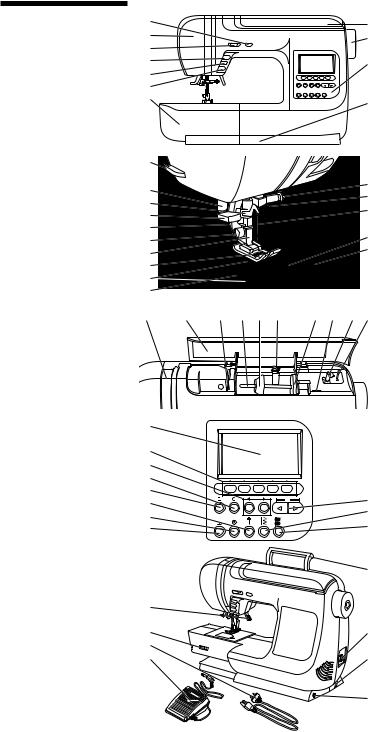
MAIN PARTS
1.Thread Cutter Button
2.Face Plate
3.Speed Control Button
4.Needle Up-Down / Slow Button
5.Reverse Button
6.Start/Stop Button
7.Removable extension table
8.Top Cover
9.Hand Wheel
10.Control Panel
11.Stitch Balance Adjusting Screw (underneath machine)
12.Thread Cutter
13.Buttonhole Lever
14.Needle Threader
15.Needle Threader Lever
16.Presser Foot Release Lever
17.Presser Foot Thumb Screw
18.Presser Foot Holder
19.Presser Foot
20.Feed Dogs
21.Needle Plate
22.Needle Clamp Screw
23.Needle Thread Guide
24.Needle
25.Bobbin Cover
26.Bobbin Cover Latch
27.Thread Take-Up Lever (Inside)
28.Pattern Chart
29.Thread Guide Plate
30.Spool Pin
31.Spool Cap
32.Bobbin Winder Thread Guide
33.Felt Washer
34.LCD Contrast Control
35.Bobbin Winder Shaft
36.Bobbin Winder Stop
37.Liquid Crystal Display (LCD)
38.Function Buttons (F1 - F5)
39.Cursor Buttons
40.Clear Button
41.Edit Button
42.Twin Needle Button
43.Tack Button
44.Straight Stitch Button
45.Scroll Buttons
46.Utility Stitch Button
47.Decorative Stitch & Letter Button
48.Presser Foot Lifter
49.Drop Feed Lever
50.Power Line Cord
51.Foot Controller
52.Handle
53.Power Switch
54.Terminal Box
55.Controller Jack
1 |
|
|
|
|
|
|
|
|
8 |
2 |
|
|
|
|
|
|
|
|
9 |
3 |
|
|
|
|
|
|
|
|
|
4 |
|
|
|
|
|
|
|
|
10 |
5 |
|
|
|
|
|
|
|
|
|
6 |
|
|
|
|
|
|
|
|
|
7 |
|
|
|
|
|
|
|
|
11 |
12 |
|
|
|
|
|
|
|
|
|
13 |
|
|
|
|
|
|
|
|
22 |
|
|
|
|
|
|
|
|
23 |
|
14 |
|
|
|
|
|
|
|
|
|
|
|
|
|
|
|
|
|
24 |
|
15 |
|
|
|
|
|
|
|
|
|
|
|
|
|
|
|
|
|
|
|
16 |
|
|
|
|
|
|
|
|
25 |
17 |
|
|
|
|
|
|
|
|
|
|
|
|
|
|
|
|
|
26 |
|
18 |
|
|
|
|
|
|
|
|
|
|
|
|
|
|
|
|
|
|
|
19 |
|
|
|
|
|
|
|
|
|
20 |
|
|
|
|
|
|
|
|
|
21 |
|
|
|
|
|
|
|
|
|
27 |
28 |
29 |
30 |
31 |
32 |
33 |
34 |
35 |
36 |
37 |
|
|
38 |
|
|
39 |
|
|
40 |
|
|
41 |
45 |
|
42 |
||
46 |
||
43 |
||
47 |
||
44 |
||
|
|
52 |
48 |
|
49 |
53 |
50 |
|
51 |
54 |
|
55 |
|
5 |
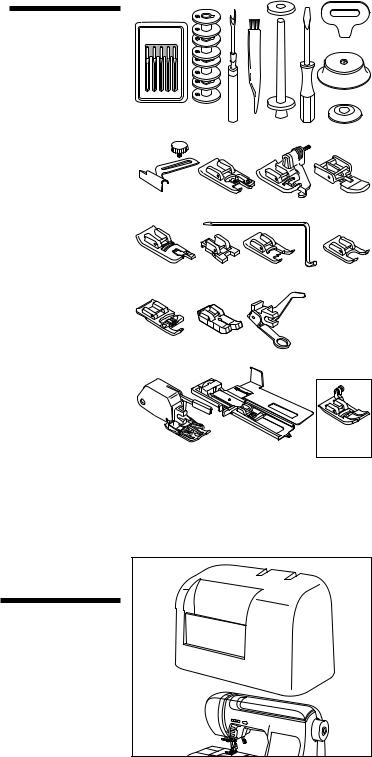
ACCESSORIES
Accessories are provided in the accessory case. (See next page, [REMOVABLE EXTENSION TABLE])
1.Needle Pack
2.4 Bobbins Class 15 (1 is in the machine)
3.Seam Ripper
4.BrushN
5.Auxiliary Spool Pin with Felt Washer
6.Screw Driver
7.Driver for Needle Plate
8.Thread Cap (On the machine when delivered)
9.Small Thread Cap
10.Seam Guide and Screw
11.Overcasting Foot (C)
12.Blind Hem Foot (D)
13.Zipper Foot (E)
14.Rolled Hem Foot
15.Button Sewing Foot
16.Satin Foot (B)
17.Quilting Bar
18.Open Toe Foot
19.Cording Foot
20.Straight Stitch / Patch Quilting Foot
21.Darning Embroidery Foot
22.Even-feed Foot
23.Buttonhole Foot (F) and Under Plate
24.General Purpose Foot (On machine when delivered) (A)
•An Extra Wide Table is provided with this machine. (See Page 11)
7
8
1 2
3 |
4 |
5 |
6 |
9 |
10 |
11 |
12 |
13 |
14 |
15 |
16 |
17 |
18 |
19 |
20 |
21 |
OPTIONAL ACCESSORIES |
|
22 |
23 |
24 |
|
1. |
Invisible Zipper Foot |
8. |
Shank w/o metal |
|
|
2. |
Snap on Gathering Foot |
9. |
Adjustable Bias Binder |
|
|
3. |
Parallel Sewing Foot |
10. |
Braiding Foot |
|
|
4. |
Edge Joining Foot |
11. |
Braiding Guide |
|
|
5. |
Clear Seam Guide Foot |
12. |
Fancy Trim Foot |
|
|
6. |
Chenille Stitching Foot |
13. |
Stitch in the Ditch Foot/ Quilt Foot with Center Guide |
|
|
7. |
Non Stick Glide Foot |
14. |
Clearance Plate |
|
|
DUST COVER
Cover the machine with dust cover when it is not being used.
The manual may be stored in the compartment of the dust cover.
Do not remove the styrofoam located inside of this cover.
6
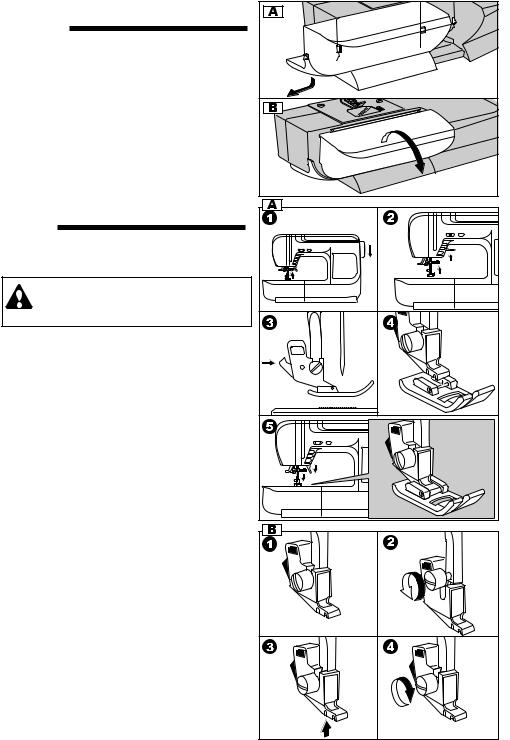
REMOVABLE EXTENSION TABLE
A.REMOVING THE EXTENSION TABLE
Hook your finger to the left bottom side of the removable extension table and slide it to the left. To attach, insert to the right.
B.OPENING THE ACCESSORY CASE
Hook your finger to the left side of accessory case and pull toward you.
CHANGING THE PRESSER FOOT
The presser foot must be changed according to the stitch you sew, or work you do.
CAUTION: To prevent accidents.
Turn off the power switch before you change the presser foot.
A.CHANGING THE PRESSER FOOT
1. Turn the hand wheel toward you until the needle is at its highest point.
2. Raise the presser foot lifter.
3. Remove the presser foot by pushing the presser foot release lever toward you.
4. Place desired foot with its pin directly under the slot in presser foot holder.
5. Lower the presser foot lifting lever and the presser foot will snap into place.
B.REMOVING THE PRESSER FOOT HOLDER
When attaching presser feet that have their own shank, or when cleaning the machine, you should remove the presser foot holder.
1.Remove the presser foot.
2.Loosen the presser foot thumb screw and remove the presser foot holder.
3.To replace the holder, pull up the holder as far as it will go from bottom of presser bar.
4.Tighten the thumb screw.
7
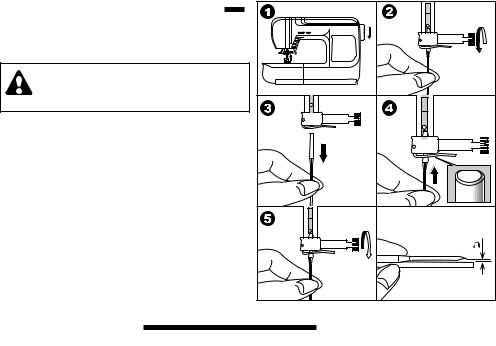
INSERTING THE NEEDLE
Select a needle of the right type and size for the fabric to be sewn.
CAUTION: To prevent accidents.
Turn off the power before removing the needle.
1. Turn the hand wheel toward you until the needle is at its highest point.
2. Loosen the needle clamp screw.
3. Remove the needle.
4. Insert new needle into needle clamp with the flat side to the back and push it up as far as it will go.
5. Tighten the needle clamp screw.
a. Do not use the bent or blunt needle. Place needle on a flat plate to check straightness.
FABRIC, THREAD AND NEEDLE TABLE
Select size of thread and needle in accordance with fabric to be sewn.
Type of Fabric |
Thread Size |
Needle |
Needle Size |
|
|
Type |
|
|
|
|
|
Light Weight - thin georgette, |
All-purpose polyester, fine |
2000 |
|
organdy, voile, taffeta, silk, |
cotton, silk |
gray shank |
9/70-11/80 |
etc. |
|
|
|
|
|
|
|
Medium Weight - gingham, |
All-purpose polyester, fine |
2000 |
|
pique, linen, cotton, satin, thin |
cotton, machine quilting |
gray shank |
11/80-14/90 |
corduroy, velvet |
|
|
|
|
|
|
|
Heavy Weight - gabardine, |
All-purpose polyester, heavy |
2000 |
14/90-16/100 |
tweed, denim, corduroy |
duty, topstitching thread |
gray shank |
|
|
|
|
|
Stretch - double knit, tricot, |
All purpose polyester |
2001 |
11/80-14/90 |
spandex, jersey |
|
green shank |
Needle for knit and |
|
|
|
synthetic fabric |
|
|
|
|
Sweatshirt, Swim-wear, |
All purpose polyester |
2001 |
|
Double Knit, Sweater Knit |
|
green shank |
|
|
|
|
|
Leather |
All purpose polyester, heavy |
2032 Leather |
|
|
duty, topstitching thread |
|
|
|
|
|
|
SINGER brand needles are recommended for this machine.
8
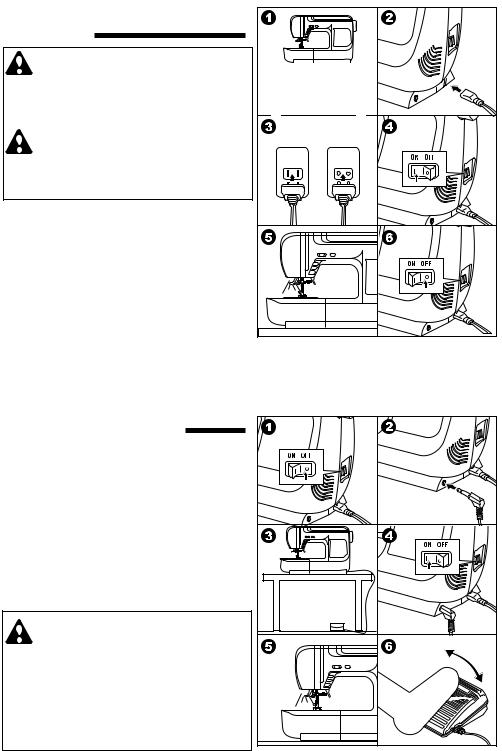
CONNECTING THE
MACHINE
DANGER: To reduce the risk of electric shock.
Never leave unattended when plugged in. Always unplug this machine from the electric outlet immediately after using and before maintenance.
WARNING: To reduce the risk of burns, fire, electric shock, or injury to persons.
Do not unplug by pulling on cord. To unplug, grasp the plug, not the cord.
1. Place machine on stable table.
2. Connect the power line cord to the machine by inserting the 2-hole plug into the terminal box.
3. Connect the power line plug to the electric outlet.
4. Turn on the power switch.
5. A lamp will light up when switch is turned on.
6. To disconnect, turn the power switch to the off position (symbol O), then remove plug from
outlet.
FOR UNITED STATES AND CANADA USERS: POLARIZED PLUG INFORMATION
This appliance has a polarized plug (one blade wider than the other). To reduce the risk of electric shock, this plug is intended to fit in a polarized outlet only one way. If the plug does not fit fully in the outlet, reverse the plug. If it still does not fit, contact a qualified electrician to install the proper outlet. Do not modify the plug in any way.
FOOT CONTROLLER
Use of foot controller will permit control of start, stop and speed with your foot.
When the foot controller is connected, start/stop button will be deactivated. (See page 10)
1.Turn off the power switch. (symbol O)
2.Push foot controller plug into the jack on machine.
3.Place foot controller at your feet.
4.Turn on the power switch.
5.A lamp will light up when switch is turned on.
6.The harder you press the foot controller, the faster the machine will sew. The machine will stop when foot controller is released.
WARNING: To reduce the risk of burns, fire, electric shock, or injury to persons.
1.Turn off the power when connecting the foot controller to the machine.
2.Handle the foot controller with care and avoid dropping it on the floor. Be sure not to place anything on top of it.
3.Use only foot controller provided with this machine. (Type 4C-337B)
9 |
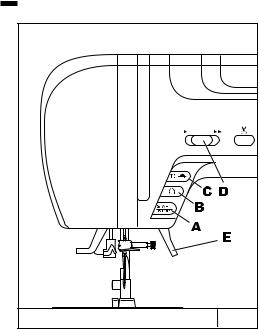
FUNCTION OF EACH PART
A.START/STOP BUTTON
The machine will start running when start/stop button is pressed and will stop when pressed the second time. The machine will rotate slowly at start of sewing.
Note:
When the foot controller is connected, start/stop button will be deactivated.
MONITOR LAMP
Green Light “ON”
Ready to sew or bobbin winding.
Red Light “ON”
Presser foot is not in down position or buttonhole lever is not lowered.
If the red light is on, the machine will not start even when start/stop button is pressed.
B.REVERSE STITCH BUTTON
The machine will continue to sew in reverse at low speed while this button is pressed and stop when this button is released.
Note:
When the foot controller is connected, machine will sew in reverse while this button is pressed. When released, machine will sew forward.
C.NEEDLE UP-DOWN / SLOW BUTTON
Pressing this button when the machine is stopped, will change the needle position from down to up or from up to down.
While sewing, by pressing this button, machine will sew in slow speed. Pressing this button again, the speed will return.
D.SPEED CONTROL BUTTON
The machine will sew faster when the button is slid to the right, and sew slower when the button is slid to the left.
Note:
When the foot controller is connected, this button limits the maximum speed.
E. PRESSER FOOT LIFTER
The presser foot is lifed up or down by this lever. Note: Machine will not start when the presser foot is lifted. (Except for bobbin winding)
10

F. THREAD CUTTER BUTTON
Press this button after sewing to cut the upper and bobbin threads.
The machine will cut both threads automatically.
CAUTION
1.Do not press this button when there is no fabric in the machine or no need to cut the threads. The thread may tangle, resulting in damage.
2.Do not use this button when cutting thread thicker than #30, nylon thread or other speciality threads.
In this case, use the thread cutter (H).
G.DROP FEED LEVER
The feed dogs project up through the needle plate, directly below the presser foot. Their function is to move the fabric being sewn. The drop feed lever controls the feed dogs.
For ordinary sewing, move the lever to the right. This raises feed dogs to their highest position. For most sewing, the lever should be in this position. For darning or free motion embroidery or whenever fabric is to be moved by hand, move the lever to the left to lower the feed dogs.
H.THREAD CUTTER
Use this cutter if the thread cutter button is not used.
1.Raise the presser foot and bring fabric and threads backward after sewing.
2.Hook the threads to the thread cutter from back to front.
3.Pull fabric and cut threads.
I. TOP COVER
To open the top cover, lift up the right side of cover.
J. HAND WHEEL
By turning the hand wheel, the needle will raise or lower. You should always turn hand wheel toward you.
EXTRA WIDE TABLE
If you need wide sewing space, attach the extra wide table as shown.
Set the machine and extra wide table on a stable table.
1.Remove the extension table (See Page 7)
2.Stand up the two legs of extra wide table.
3.Insert wide table to the machine sliding to the right.
11 |
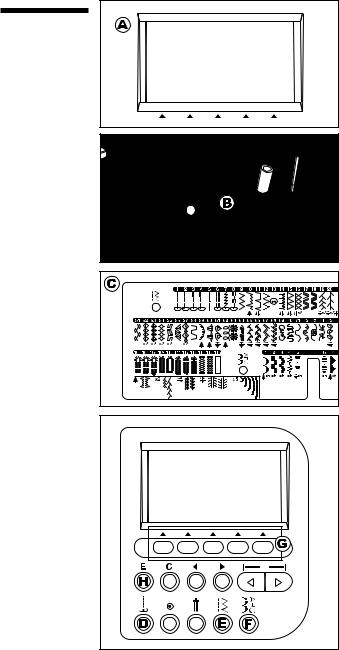
CONTROL PANEL
When you turn on the power, machine will select the straight stitch and indicate information of stitch on the LCD.
A.LCD DISPLAY
Stitch information is indicated on this display. According to the pattern or mode, information will be changed.
B.LCD CONTRAST CONTROL
The contrast of LCD is adjusted by turning this dial.
C.PATTERN CHART
Pattern chart is located inside of the top cover. Patterns and letters of this machine are indicated on this chart.
They are separated: Utility stitches and Decorative & Letter stitches.
D.STRAIGHT STITCH BUTTON
By pressing this button, you can select straight stitch directly.
E. UTILITY STITCH BUTTON
By pressing this button, you may select a utility stitch pattern.
FOR SELECTING AND SETTING OF UTILITY STITCHES, SEE PAGE 22.
F.DECORATIVE & LETTER STITCH BUTTON
By pressing this button, you can select decorative & letter stitch patterns.
These patterns and letters are combined easily by selecting each pattern.
FOR SELECTING AND SETTING OF DECORATIVE & LETTER STITCH, SEE PAGE 44.
G.FUNCTION BUTTONS
Functions of these buttons are changed by selected stitch pattern and mode.
H. EDIT BUTTON
When selecting decorative & letter stitch, you can change the setting of each pattern by pressing this button.
12
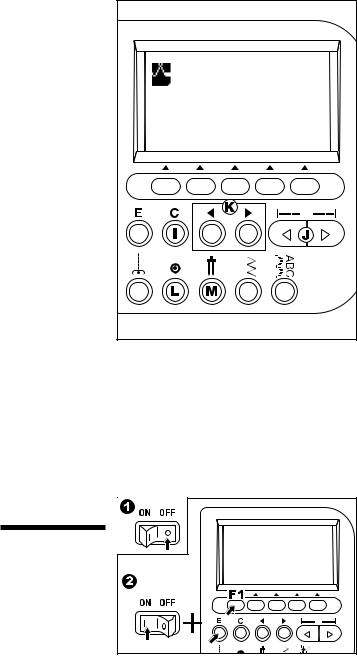
I. CLEAR BUTTON
UTILITY STITCH SEWING
If you changed the setting (mirror/reverse, elongation, stitch width, length and thread tension) of utility stitch pattern, you can return to preset setting by pressing this button.
DECORATIVE & LETTER STITCH SEWING By pressing this button, you can delete one combined stitch pattern or all stitch patterns.
J. SCROLL BUTTONS
During stitch pattern selection, 5 patterns or letters will scroll up or down by pressing these buttons.
K.CURSOR BUTTONS
When decorative & letter stitch sewing, you can check and edit combined patterns or letters by pressing these buttons.
L. TACK BUTTON
UTILITY STITCH SEWING
By pressing this button, you can sew a back tack stitch at the beginning and at the end of a stitch. (SEE PAGE 19)
DECORATIVE & LETTER STITCH SEWING
If this button is pressed at the end of a decorative stitch pattern, machine will stop automatically at the end of the stitch pattern and tie off the stitch with a locking stitch.
M. TWIN NEEDLE BUTTON
If you attach the twin needle, press this button. Machine will reduce the stitch width.
(SEE PAGE 43)
TO TURN OFF THE AUDIBLE BEEP
You can operate the machine without the audible beep.
1.Turn off the power switch.
2.Turn on the power switch while pressing the EDIT button and the function F1 button.
3.This function is kept off until the machine is turned off.
This function turns off the single beep only. Multiple beeps will not turn off.
13
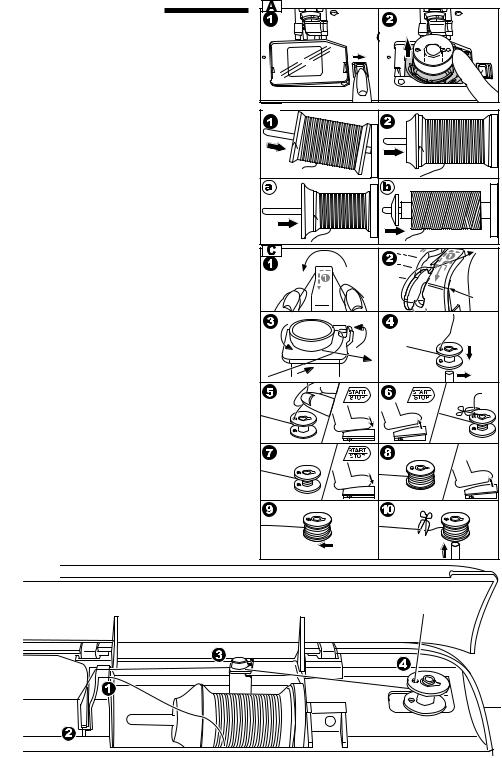
BOBBIN SETTING
Be sure to use only SINGER (Class 15) bobbins in this machine.
A.REMOVING THE BOBBIN
1. Pull the bobbin cover latch to the right and remove the bobbin cover.
2. Lift up the bobbin from the machine.
B.SETTING SPOOL OF THREAD ON SPOOL 

 PIN
PIN
1. Pull up the left end of spool pin and set the spool of thread on spool pin so that the thread unrolls
from the front of the spool.
2. Set the spool cap on spool pin as far as it will go.
a: Reverse spool cap direction according to the size of spool.
b. Use the small spool cap when you use cross wound thread. Leave small opening between cap and spool as illustration.
C.WINDING THE BOBBIN
1. Hold thread in both hands and hook thread to the guide from rear opening.
2. Bring thread forward and pass through the thread guide plate from right to left.
3. Bring thread to the right and pass thread to the thread guide from under side. Pass through under tension disc in counter-clockwise direction.
4. Insert thread through hole in bobbin and place the bobbin on bobbin winder spindle. Push bobbin to the right to engage bobbin winder. LCD will indicate the bobbin winding mode.
5. Hold the end of the thread and start the machine by pressing the start/stop button or pressing the foot controller pedal.
6. After the bobbin winds a few turns, stop the machine by pressing the start/stop button or releasing the foot controller pedal. Cut the thread near hole.
7. Start the machine again.
8. The bobbin winding will stop automatically when bobbin is full. (Release the pedal.)
9. Push the bobbin and spindle to the left.
10 Remove the bobbin from the spindle and cut the thread.
14
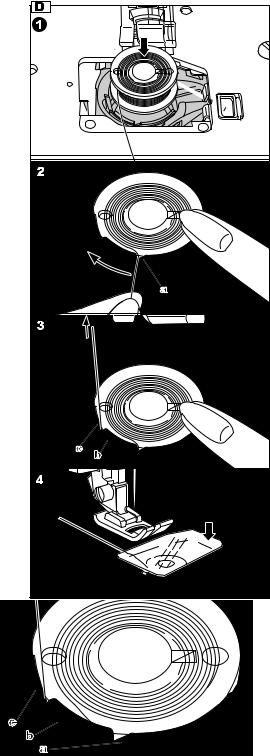
D.INSERTING THE BOBBIN
1.Place bobbin into bobbin holder with the thread unwinding counter clockwise.
2.Draw thread into notch (a) while holding the bobbin.
3.Pull thread toward the left and along the inside of spring (b) until it slips into notch (c) making sure that thread does not slip out of notch (a).
4.Pull thread out about 10 cm (4 inches). Replace the bobbin cover. Set the left tab into the hole in needle plate and push the right side of bobbin cover down until it clicks into place.
NOTE: Be sure to use only SINGER (Class 15) bobbins in this machine.
15 |
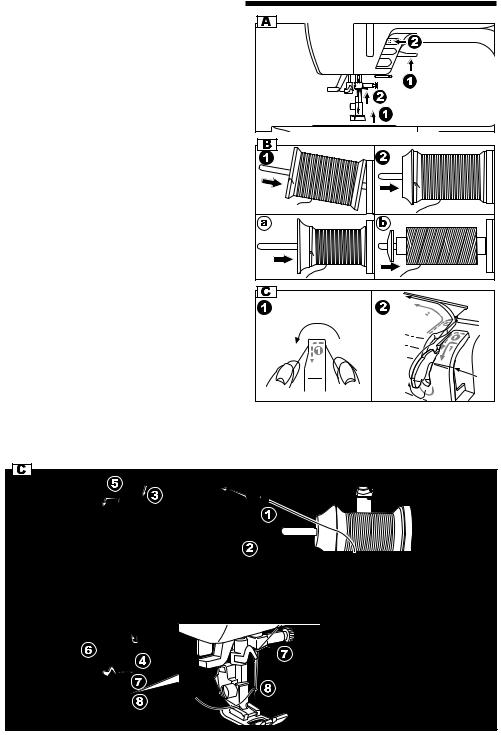
THREADING THE MACHINE
A.PREPARING TO THREAD MACHINE
1.Raise the presser foot lifter.
2.Press the needle up/down button and set the needle in up position.
(Keep this position until needle eye threading.)
B.SETTING SPOOL OF THREAD ON SPOOL PIN
1. Pull up the left end of spool pin and set the spool of thread on spool pin so that the thread unrolls
from the front of the spool.
2. Set the spool cap on spool pin as far as it will go. a: Reverse spool cap direction according to the
size of spool. b. Use the small spool cap when you use cross
wound thread. Leave small opening between cap and spool as illustration.
C.THREADING THE UPPER THREAD
1. Hold thread in both hands and pass thread to the guide from rear opening.
2. Bring thread frontward and pass through the thread guide plate from right to left.
3. Bring thread to the left and pull thread down toward you along the slit.
4. Pull up thread.
5. To thread the take-up lever, draw thread up and bring thread back down again from right to left along the slit.
6. Pull thread downward along the slit.
7. Draw thread through thread guide from right side opening.
8.Pass through needle eye from front to back. Refer to next page for instructions on how to use needle threader.
16
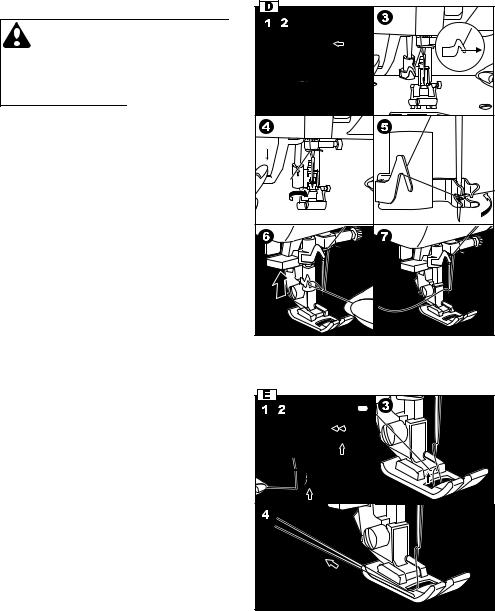
D.THREADING THE NEEDLE EYE
CAUTION: To prevent accidents.
1.Keep fingers away from all moving parts. Special care is required around the needle.
2.Do not lower the threader lever while machine is operating.
Note:The needle threader is used for needle sizes 11/80, 14/90, and 16/100.
1.Lower the presser foot.
2.Check that the needle is raised.
If it is not so, raise needle by pressing needle up/down button.
Note:
If desired, you can draw up the bobbin thread manually, by holding the upper thread loosely, then turning the hand wheel toward you one complete turn.
3.Lower the threader slowly and draw thread through thread guide (a) and pull toward the right.
4.Lower the lever as far as it will go. The threader will turn and the hook pin will go through the needle eye.
5.Draw thread into the guide.
6.Hold thread loosely and release the lever. Hook will turn and pass thread through needle eye while making a loop.
7.Pull thread out about 10 cm (4 inches) from needle eye.
E. DRAWING UP THE BOBBIN THREAD
1.Raise the presser foot.
2.Hold thread loosely and press needle up/down button twice from up position.
The hand wheel will turn one complete turn.
3.Pull upper thread lightly. Bobbin thread will come up in a loop.
4.Pull both upper and bobbin threads about 10 cm (4 inches) toward the back of presser foot.
a |
17

STARTING TO SEW
The machine will be set to sew straight stitch when power switch is turned on.
 CAUTION: To prevent accidents.
CAUTION: To prevent accidents.
While sewing, special care is required around the needle.
Machine automatically feeds the fabric, do not pull or push the fabric.
A.START AND END OF SEAM
1.Check the presser foot (General Purpose Presser Foot). Refer to page 7 for changing the presser foot.
2.Place the fabric under the presser foot and lower the presser foot.
3.Hold back both threads and press the start/stop button or press the foot controller pedal.
Keep holding threads after sewing a few stitches.
Lightly guide the fabric while sewing.
You can regulate the sewing speed by sliding the speed control button.
Also, you can reduce the sewing speed by pressing the slow button.
4.When you reach end of seam, press the start/ stop button to stop sewing or release the foot controller pedal.
5.Press the thread cutter button.
6.Raise the presser foot lifter and remove the fabric.
CAUTION
1.Do not press the thread cutter button when there is no fabric in the machine or no need to cut the threads. The thread may tangle, resulting in damage.
2.Do not use the thread cutter button when cutting thread thicker than #30, nylon thread or other speciality threads.
In this case, use the thread cutter located on the left side of the machine. (See page 11)
NOTE
After you cut the threads by using the thread cutter button, hold upper thread only at the next starting of seam. (No need to draw up the bobbin thread)
18
